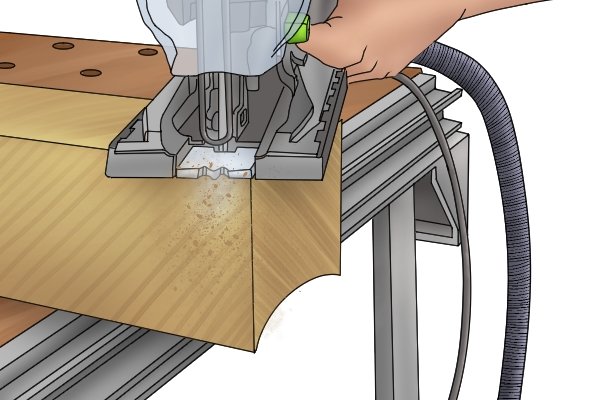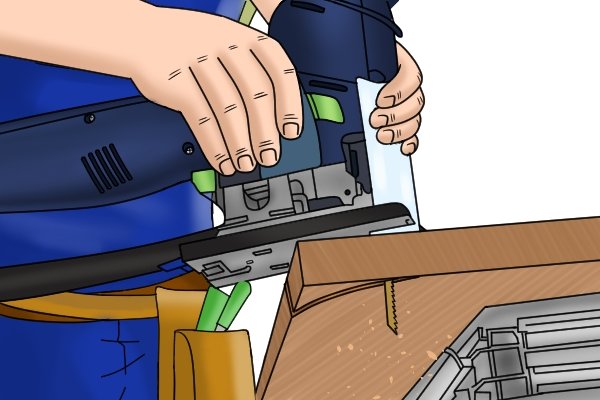Are you curious about how deep a jig saw can cut? Well, let’s dive right into the world of woodworking and find out! Jig saws, also known as scroll saws, are versatile power tools that can make intricate cuts in various materials like wood, plastic, and metal. So, if you’ve ever wondered how deep these handy tools can go, this article will answer all your burning questions.
Whether you’re a beginner or an experienced woodworker, understanding the cutting depth of a jig saw is essential. In this guide, we’ll explore the factors that determine the maximum cutting depth of a jig saw and provide you with practical tips to make the most out of this versatile tool. So, grab your safety goggles, buckle up, and let’s get started on this exciting journey!
You might be wondering why cutting depth matters when it comes to jig saws. When working on a project, knowing the limits of your tool is crucial for achieving accurate and precise cuts. We’ll explore the various factors that affect the cutting depth of a jig saw and offer insights into selecting the right blade for different materials. So, get ready to level up your woodworking game with our in-depth exploration of jig saw cutting depths!

How Deep Can a Jig Saw Cut? Understanding the Limitations and Possibilities
Jig saws are versatile power tools that are commonly used for cutting curves, intricate designs, and shapes in various materials such as wood, metal, plastic, and more. If you’re wondering how deep a jig saw can cut, it’s essential to understand the factors that affect the cutting depth and the limitations of this tool. In this article, we’ll explore the depths that a jig saw can reach, the blade types and sizes available, and tips for maximizing its cutting capabilities.
The Cutting Depth of a Jig Saw: Exploring the Factors
Jig saws have a specific cutting depth capacity, which refers to the maximum thickness of the material it can cut through. The cutting depth can vary depending on several factors:
1. Motor Power: The power of the jig saw’s motor directly influences its cutting depth. Higher-powered motors can generate more force, allowing for deeper cuts in dense or tough materials.
2. Blade Size: The size of the blade also affects the cutting depth. Jig saw blades come in various lengths, typically ranging from 2 to 6 inches. Longer blades provide a greater cutting depth, as they have more teeth and can penetrate deeper into the material.
3. Blade Type: Another crucial factor is the type of blade being used. Jig saw blades are available in different tooth configurations, including coarse, fine, and specialty blades for various materials. Coarser blades with fewer teeth have a higher cutting speed but may result in rougher cuts. Fine blades with more teeth produce smoother cuts but have a slower cutting speed.
Maximizing the Cutting Depth of a Jig Saw
To achieve the maximum cutting depth with your jig saw, consider the following tips:
1. Choose the Right Blade: Select a blade that is suitable for the material you are cutting. For example, use a blade with fine teeth for cutting delicate materials like veneer and a coarse blade for thicker materials like hardwood.
2. Adjust Blade Speed and Orbital Action: Most modern jig saws allow you to adjust the cutting speed and choose between different orbital actions. Experiment with different settings to find the optimal combination for achieving the desired cutting depth.
3. Use Proper Technique: Apply steady and consistent pressure while guiding the jig saw along the cutting line. Avoid excessive force or trying to rush through the cut, as this can lead to less accurate results and potential damage to the blade or tool.
The Limitations of a Jig Saw
While jig saws are versatile tools, they do have their limitations when it comes to cutting depth:
1. Material Density: Dense or hard materials like metal or thick hardwood may pose challenges for a jig saw, as they require more power and may exceed the cutting capacity of the tool. In such cases, alternative tools like reciprocating saws or band saws may be more suitable.
2. Blade Length: The length of the blade limits the cutting depth. Longer blades provide deeper cuts, but they may not be compatible with certain jig saw models or suitable for intricate cuts.
3. Support and Stability: When cutting thicker materials, it is crucial to ensure proper support and stability to minimize vibrations and maintain control. Using clamps or a workbench can help achieve better results.
In conclusion, the cutting depth of a jig saw is determined by factors such as motor power, blade size, and blade type. By understanding these factors and implementing proper techniques, you can effectively maximize the cutting depth and achieve precise and accurate cuts. However, it is important to be aware of the limitations of a jig saw and consider alternative tools for specific materials or cutting requirements. Always prioritize safety and follow the manufacturer’s guidelines for the best results.
Key Takeaways: How Deep Can a Jigsaw Cut?
- A jigsaw can cut through various materials like wood, metal, plastic, and even ceramic tiles.
- The maximum depth a jigsaw can typically cut is around 2-3 inches.
- It’s important to use the appropriate blade for the material you’re cutting to achieve the best results.
- Always ensure proper safety precautions, such as wearing eye protection and securing the workpiece firmly.
- Understanding the capabilities of your jigsaw and adjusting the speed and stroke settings can improve cutting efficiency.
Frequently Asked Questions
If you’re wondering about the cutting abilities of a jig saw, look no further. We have answers to all your questions about how deep a jig saw can cut!
What is the maximum cutting depth of a jig saw?
Jig saws are incredibly versatile tools capable of cutting through a variety of materials. The maximum cutting depth of a jig saw typically ranges from around 2 to 4 inches, depending on the specific model and blade being used. It’s important to refer to the manufacturer’s guidelines to determine the exact cutting depth of your particular jig saw.
Keep in mind that the maximum cutting depth may vary based on the material you’re working with. Cutting depth can be affected by factors such as the density and thickness of the material, as well as the type and sharpness of the blade.
Can a jig saw cut through metal?
Yes, a jig saw can cut through metal, but it’s essential to use the appropriate blade and technique to achieve clean and accurate cuts. When cutting metal with a jig saw, it’s recommended to use a fine-toothed blade specifically designed for metal cutting. These blades typically have small, closely spaced teeth that create less vibration and reduce the risk of chipping or damaging the metal surface.
Additionally, it’s important to set the jig saw to a lower speed and apply light to moderate pressure while cutting through metal. This allows for better control and reduces the likelihood of the blade overheating or becoming dull prematurely.
Is it possible to cut curves with a jig saw?
Absolutely! One of the main advantages of a jig saw is its ability to cut intricate curves with ease. Thanks to the up-and-down reciprocating motion of the blade, a jig saw is perfect for creating smooth and precise curved cuts in various materials, such as wood, plastic, and laminate.
To cut curves with a jig saw, start by marking the desired curve on your material. Then, carefully guide the jig saw along the marked line, allowing the blade to do the cutting. It’s important to make sure the blade is properly aligned and that you maintain a steady hand for optimal results.
Can I use a jig saw to cut thick pieces of wood?
While jig saws are primarily designed for cutting thinner materials, they can still be used to cut thicker pieces of wood with some limitations. The cutting depth of your jig saw will determine the thickness of the wood it can handle. It’s advisable to refer to the manufacturer’s guidelines for the exact cutting depth of your specific jig saw model.
If you need to cut thicker pieces of wood that exceed the cutting depth of your jig saw, you may consider making multiple passes or using alternative cutting tools, such as a circular saw or a table saw. These tools are better suited for cutting through thick pieces of wood with precision and efficiency.
How do I ensure a clean and splinter-free cut with a jig saw?
To achieve a clean and splinter-free cut with a jig saw, there are a few techniques you can employ. First, ensure you’re using a sharp blade appropriate for the material you’re cutting. Dull or incorrect blades can cause tear-out and splintering. Using a fine-toothed or specialized blade designed for clean cuts can make a significant difference.
Second, when cutting wood, consider placing a sacrificial piece of plywood or cardboard underneath the material to prevent tear-out on the underside. Additionally, it can be helpful to apply masking tape along the cut line to reduce splintering. Finally, cutting at a slower speed and maintaining a steady hand will also contribute to cleaner, more precise cuts.

Cutting Large Beams
Summary
Jig saws can cut through different materials like wood, metal, and plastic. The depth of the cut depends on the type of blade and the power of the saw. It’s important to choose the right blade for the material you’re cutting and adjust the speed of the saw accordingly. Jig saws are versatile tools, but always use caution and wear safety equipment.
Overall, jig saws are handy tools for various projects. They can cut up to 3 inches in wood, 1/2 inch in metal, and a similar thickness in plastic. Remember to read the instructions and follow safety guidelines to ensure a successful and safe cutting experience.
